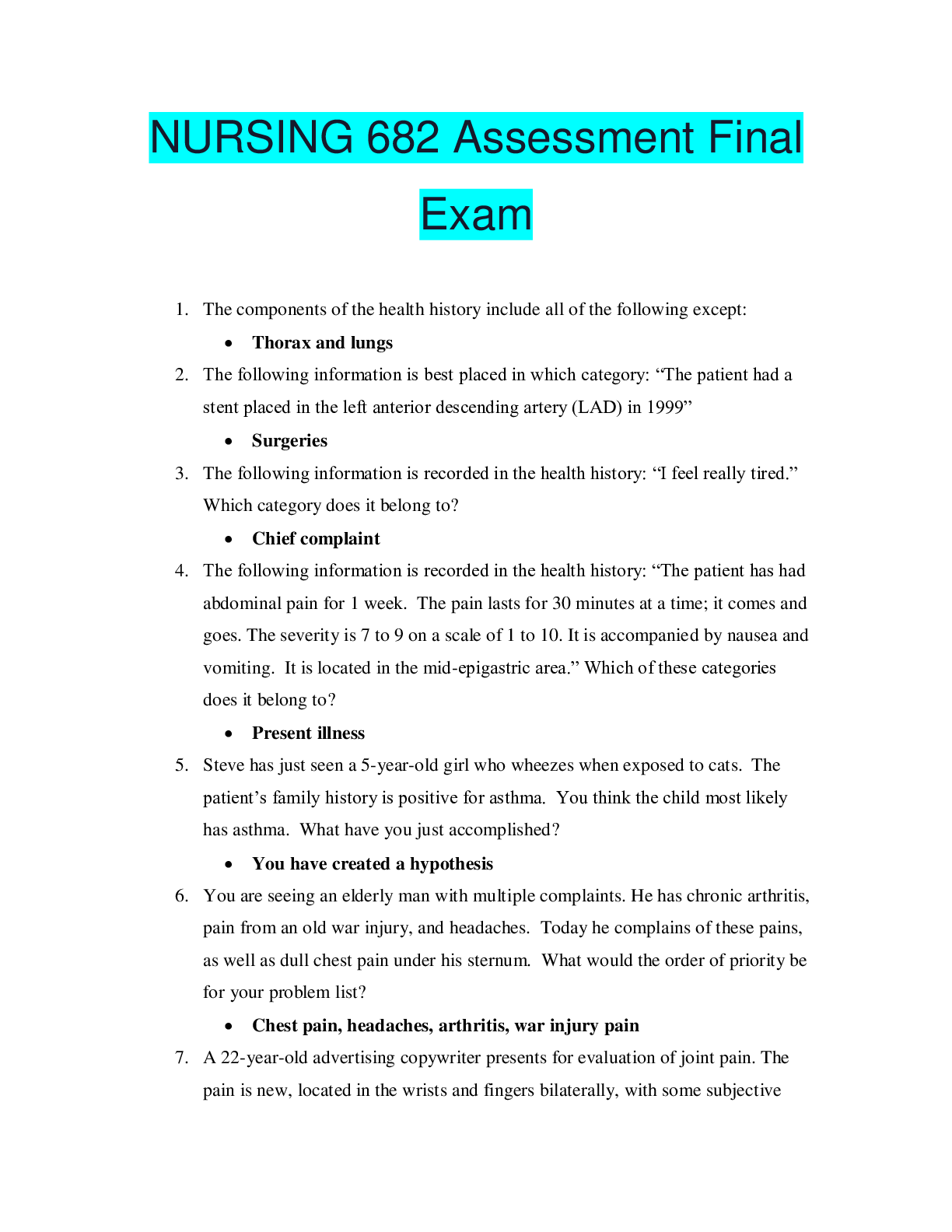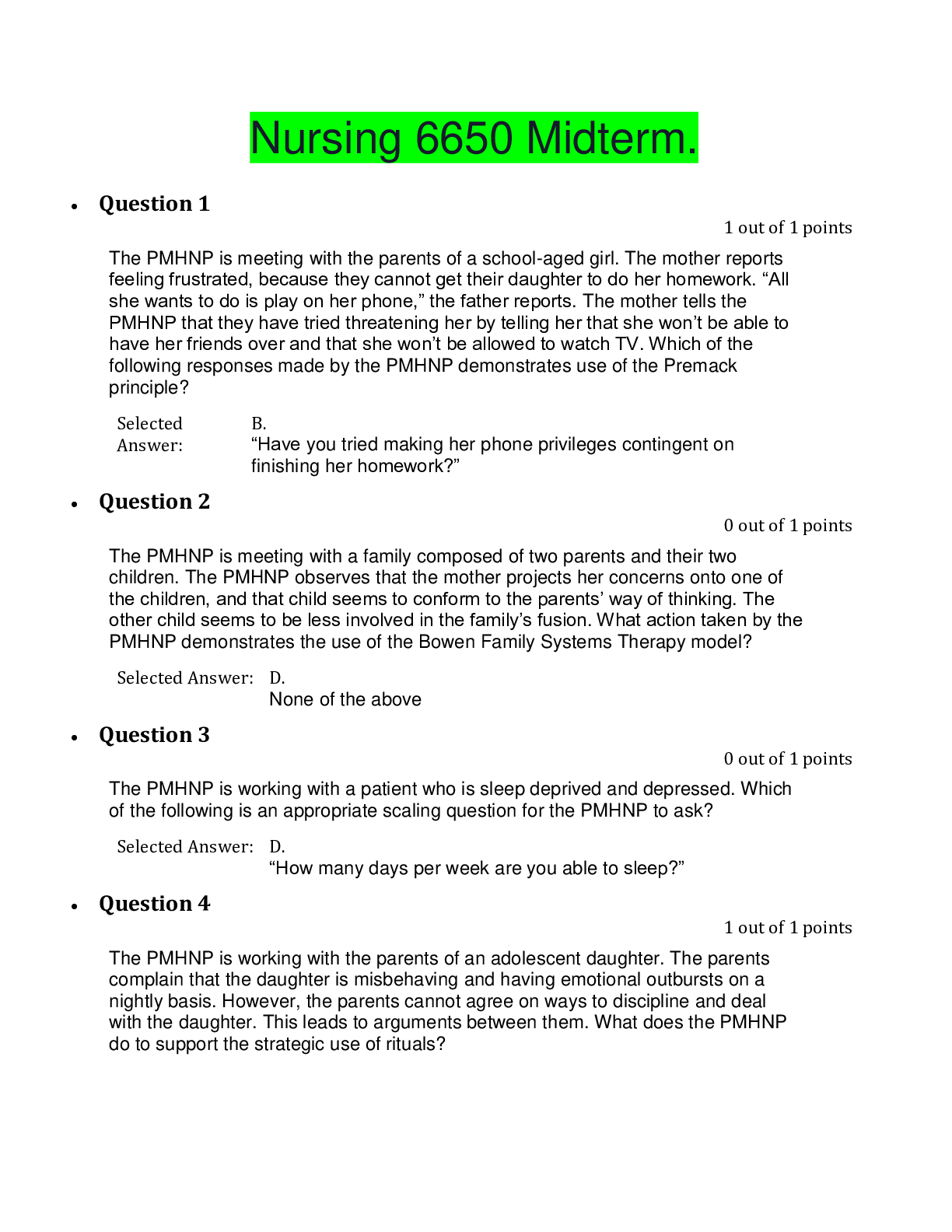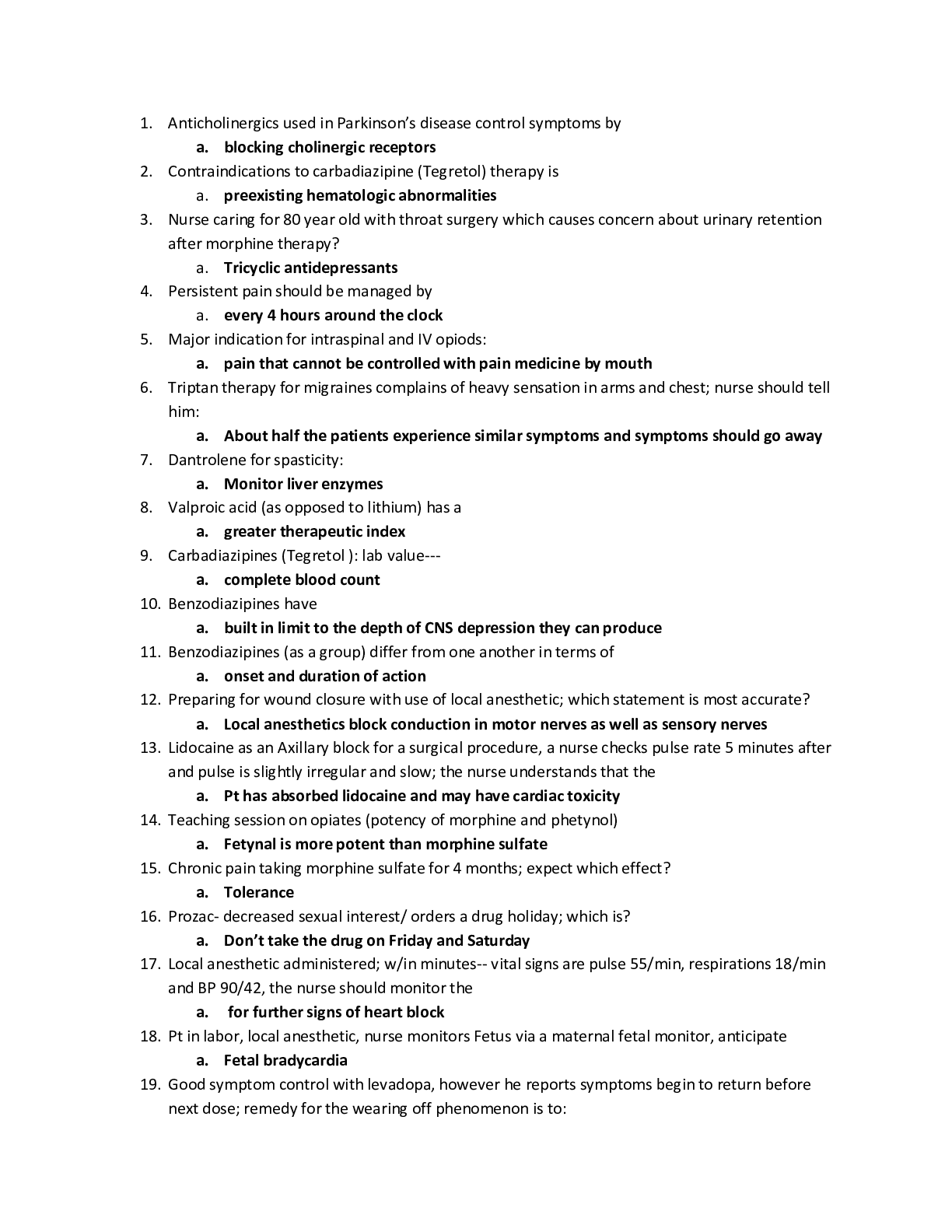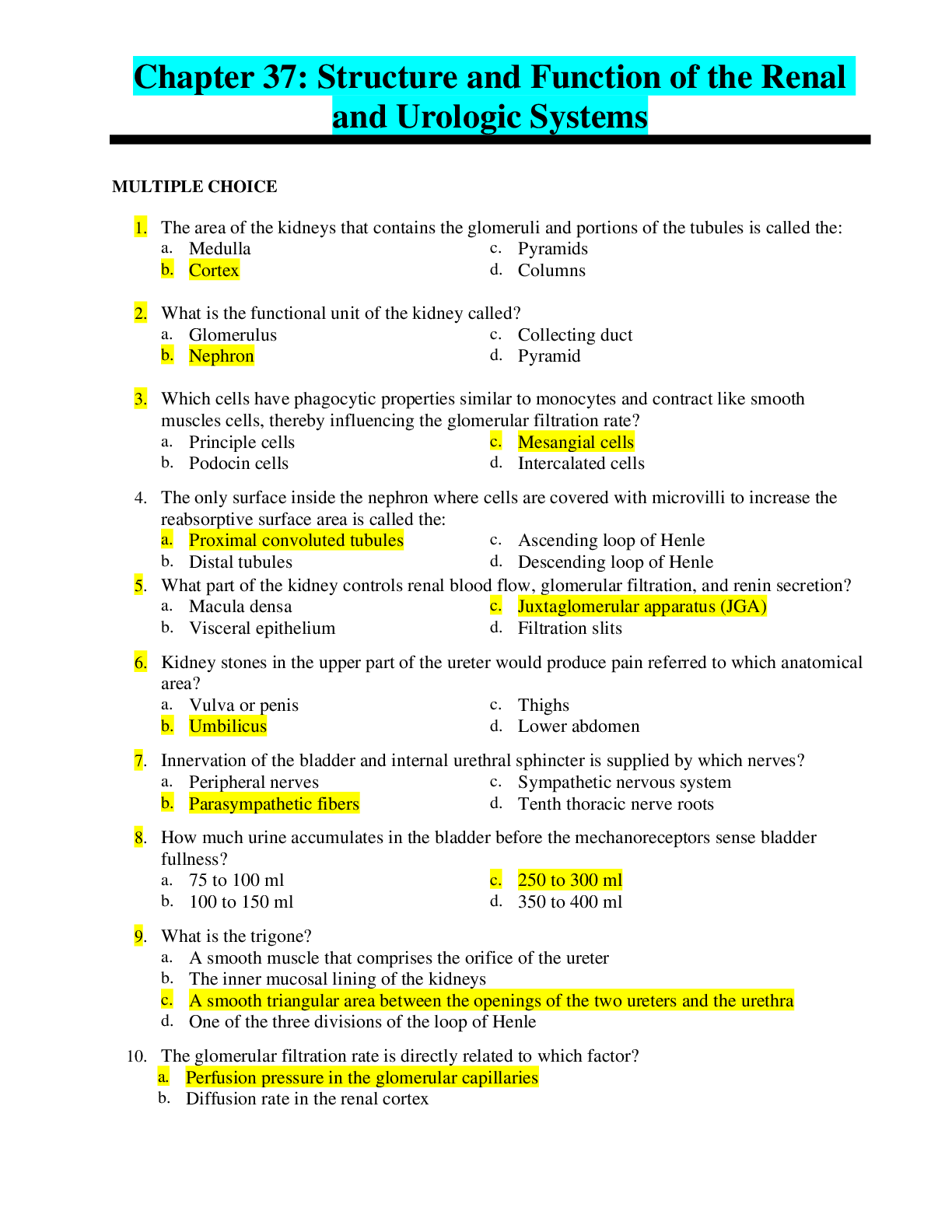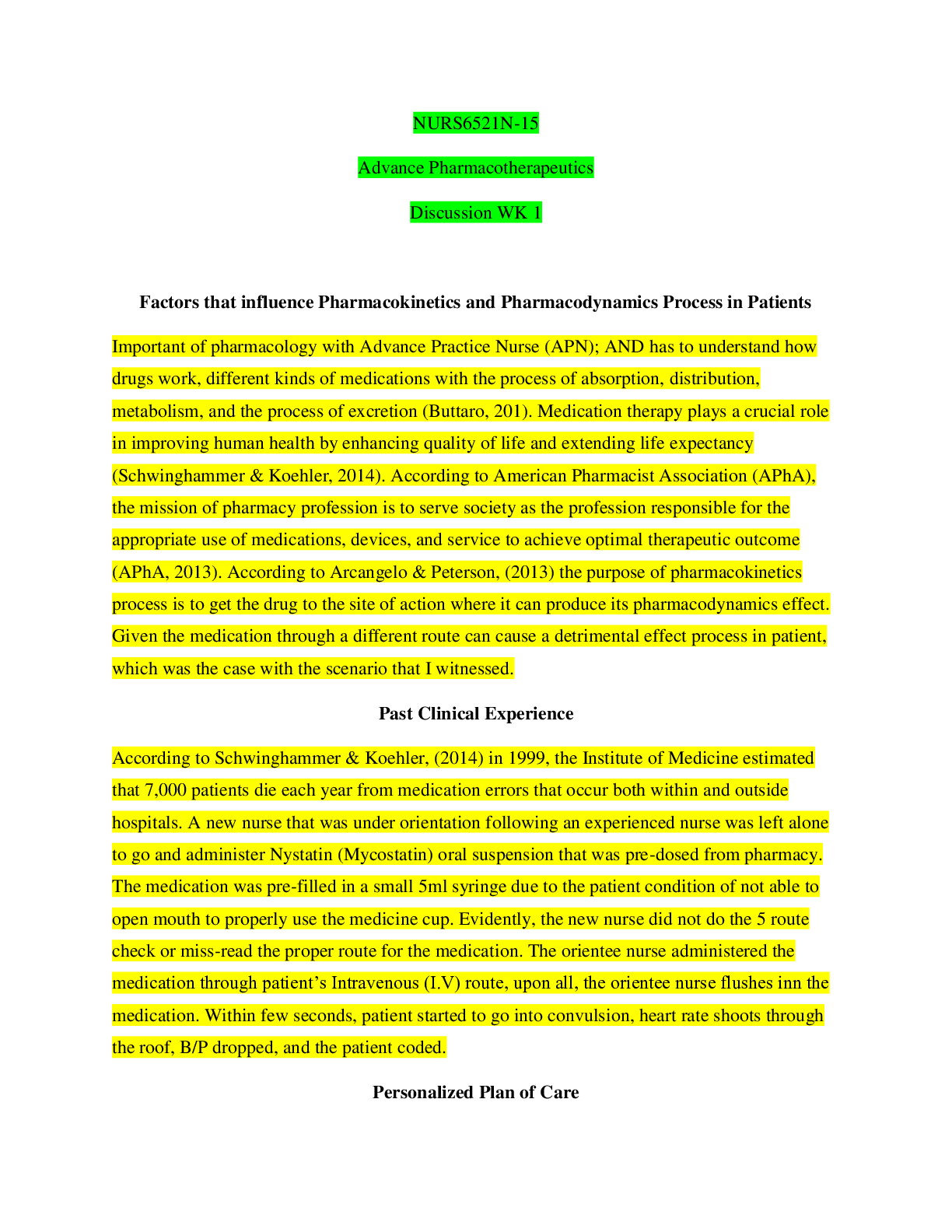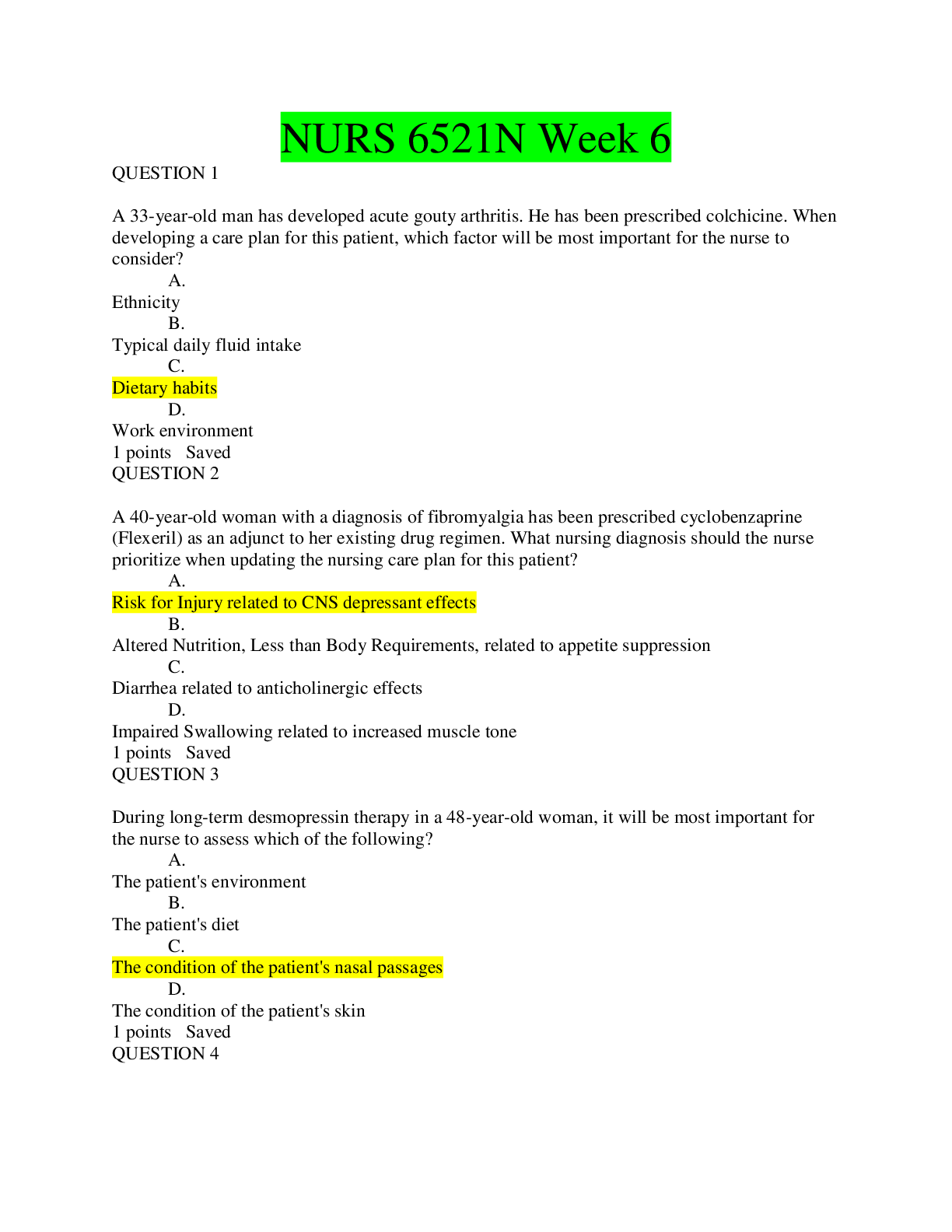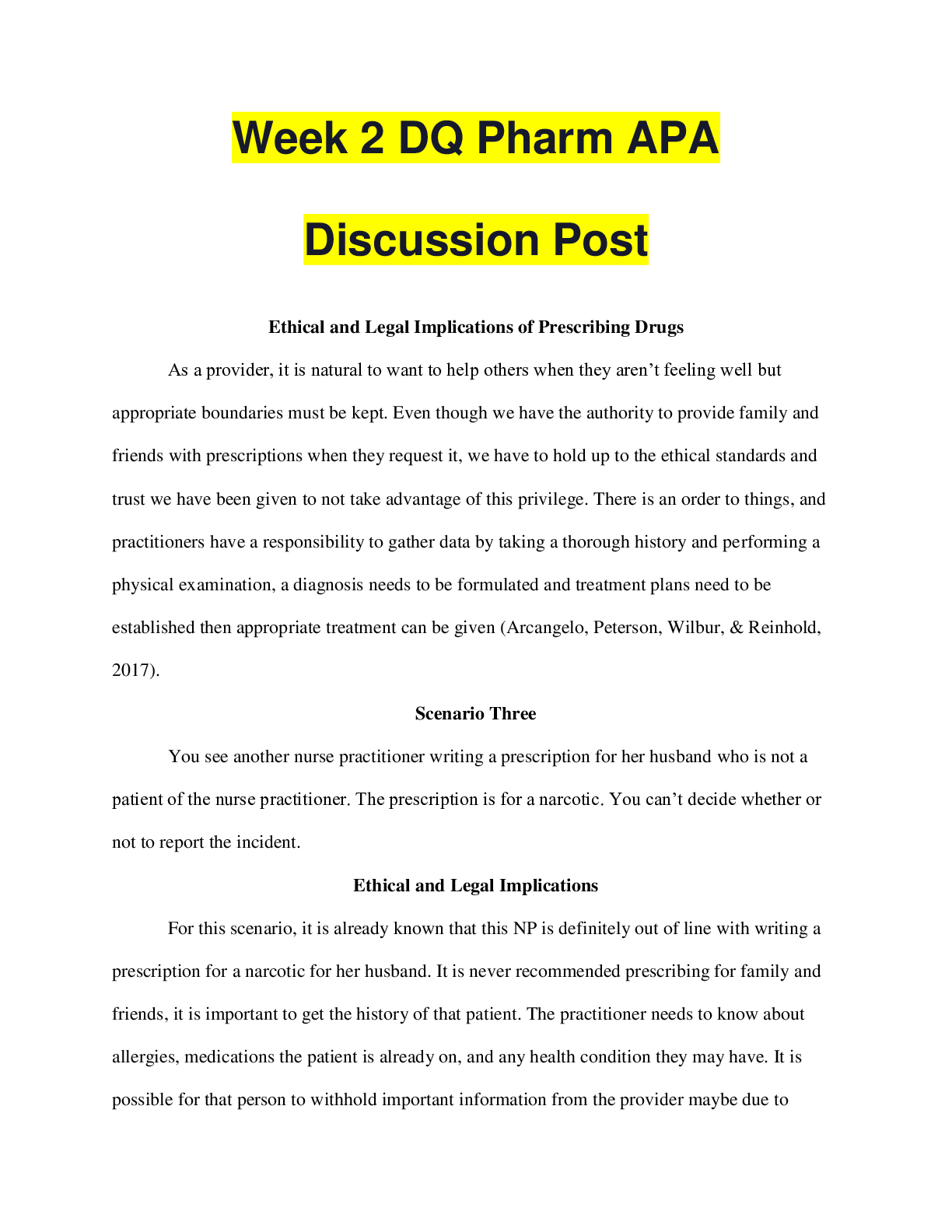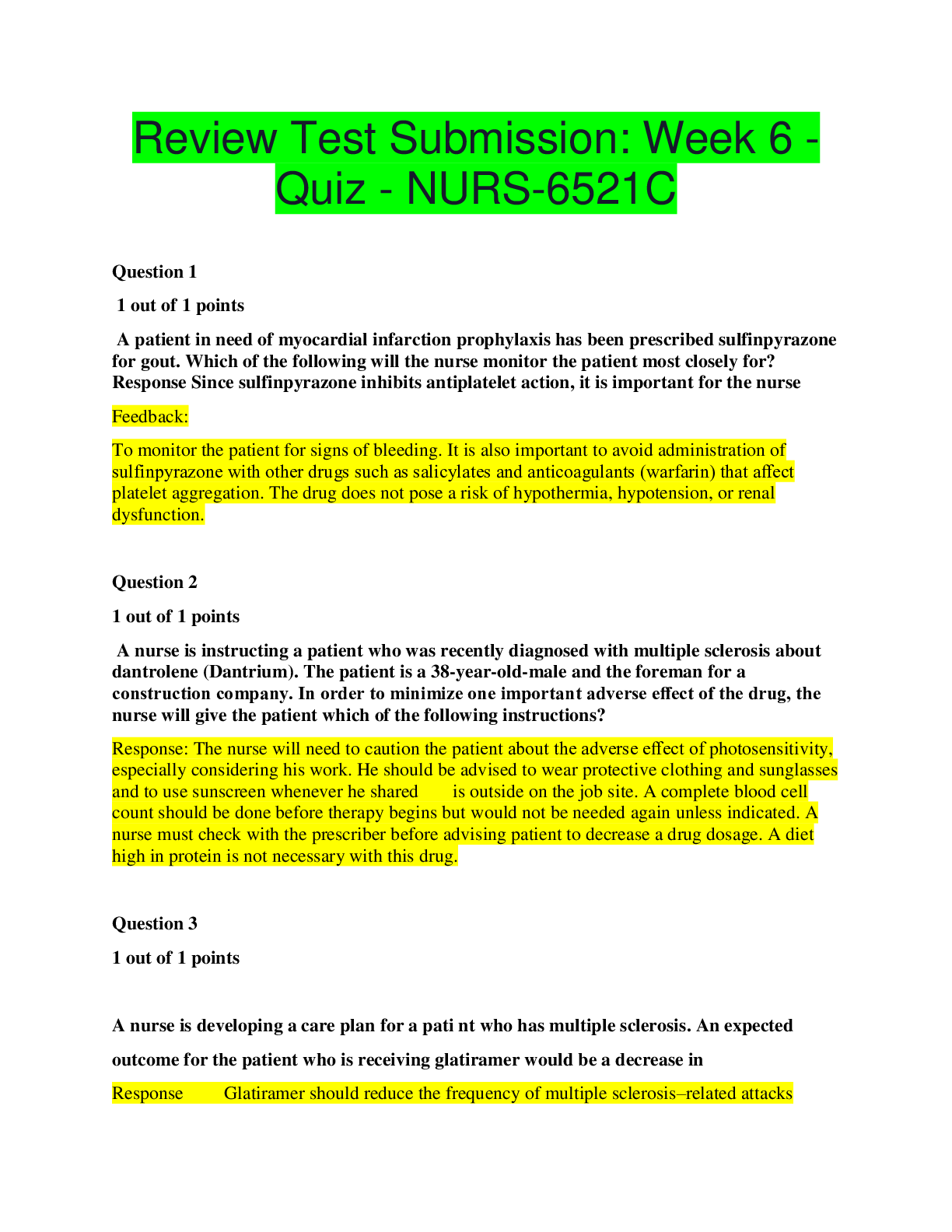*NURSING > QUESTIONS & ANSWERS > Grand Canyon University > NUR 634 Chapter 18 FINALS (ALREADY GRADED A) (All)
Grand Canyon University > NUR 634 Chapter 18 FINALS (ALREADY GRADED A)
Document Content and Description Below
. Chapter 18 1. During the delivery of a male infant, you are there to assess the Apgar score. He was born through an intact pelvis and had no complications during labor or delivery. At 1 minute ... he is pink all over and grimaces. He is flexing his arms and legs occasionally. He is breathing well and his heart rate is 110. At 5 minutes he is still pink all over but now is crying vigorously, with active movement. His respiratory effort is good and his heart rate is 130. What is his Apgar score? A) 8 at 1 minute, 10 at 5 minutes B) 7 at 1 minute, 9 at 5 minutes C) 9 at 1 minute, 10 at 5 minutes D) 8 at 1 minute, 9 at 5 minutes 2. A 24-year-old mother who is a smoker and cocaine addict gave birth at 39 weeks to a 2,000-gram female infant who is in the neonatal intensive care unit. Using the Intrauterine Growth Curve chart, you determine whether the infant's weight is appropriate for her gestational age. In which category does the infant best fit? A) Large for gestational age B) Normal for gestational age C) Small for gestational age 3. A mother brings her 16-month-old son in for an evaluation. She is afraid he is not meeting his developmental milestones and wants to know if he should be sent to therapy. He was the product of an uneventful pregnancy and a spontaneous vaginal delivery. His Apgar scores were 7 and 9. Until reaching a year old the mother believes he was hitting his milestones appropriately. You decide to administer the Denver Developmental Screening Test. You find that he is using a spoon to eat with and can take off his own shoes and shirt. He can build a tower of two cubes and dump raisins. His vocabulary consists of at least 10 words. He can stand alone and stoop and recover, but he is unable to walk without holding onto someone's hand. What type of developmental delay does he have? A) Personal/social B) Fine motor C) Language D) Gross motor 4. A foster mother brings a 4-year-old child to see you for an evaluation. She has had custody of the girl for 2 weeks. She knows that the child was born in your state and that her maternal grandmother had custody for 6 months. She received good medical care during that time, but after her biologic mother obtained custody the child was abused and has had no further medical care. She says the child has had many behavioral problems and seems to be very behind on her developmental tasks. When you examine the child you notice short palpebral fissures, a wide nasal philtrum, and thin lips. Her cardiac, pulmonary, musculoskeletal, and abdominal examinations are normal. Her Denver Developmental Screening Test shows most of her milestones have occurred only through the 24th month. What form of congenital retardation is she most likely to have? A) Fetal alcohol syndrome B) Congenital hypothyroidism C) Down syndrome 5. A young Hispanic mother brings in her 2-month-old son. She is upset because her neighbors have threatened to call the Child Protective Agency because they think his birthmark is a bruise. Her son was the product of an uneventful pregnancy and spontaneous vaginal delivery. On examination you see a large, smooth-bordered bluish mark on his buttock and lower back. Otherwise his examination is unremarkable. What form of birthmark is this likely to be? A) Café-au-lait spot B) Salmon patch C) Mongolian spot 6. A 32-year-old white female presents to labor and delivery fully effaced and delivers a 5.8-lb (2,500-gram) infant female with Apgar scores of 6 and 8. The mother has had no prenatal care and in the nursery you perform the newborn examination. With the Ballard scoring system, the neuromuscular examination score is 15. Looking at physical maturity, you see superficial peeling and few veins on the skin. The lanugo hair has bald areas and the plantar surface of the foot has creases on two thirds of it. The areola is stippled with a 2-mm bud. The pinna is well curved, is firm, and has instant recoil. The labia majora and minora are equally prominent. Add the score of the neuromuscular components to your score of physical maturity to determine weeks of gestation. How many weeks of gestation has this child had? A) 34 weeks B) 36 weeks C) 40 weeks 7. A mother brings in her 3-year-old son for a well-child check-up. She is concerned that he seems different in size from all of the other preschool boys. He was the product of an uneventful pregnancy and vaginal delivery. He has hit all of his developmental milestones on time. On examination he is 26 lbs (11.8 kg) and is 35 inches (89 cm) tall. Otherwise his examination is unremarkable. You give the correct education for his age and then discuss his size. For his age, what are his growth chart percentiles? A) Tall and heavy for his age (>95%) B) Average height and weight for his age (5 to 95%) C) Small and light for his age (<5%) 8. A mother brings her 4-year-old daughter to your office because of fever and decreased eating and drinking. When you ask the little girl what is wrong, she says her mouth and throat hurt. On examination her temperature is 101 degrees. Her ears and nose examinations are unremarkable. Her mouth has ulcerations on the buccal mucosa and the tongue. She also has cervical lymphadenopathy. Her cardiac and pulmonary examinations are normal. She is up to date on her childhood vaccinations. What mouth abnormality does she most likely have? A) Strep throat B) Herpetic stomatitis C) Oral candidiasis (thrush) D) Diphtheria 9. A mother brings her 15-month-old daughter to your office for evaluation of a rash and fever. She says the rash started one day and the fever developed the next day. Her daughter has had all of her vaccinations up to 10 months. The mother sheepishly admits that she hasn't had time to bring her daughter in since her 10-month check-up. On examination you see a mildly sick-appearing toddler with a 102-degree temperature. Looking at her skin you see at least 100 of a variety of papules, vesicles, and ulcers in different stages of development. What illness prevented by proper vaccination does this toddler have? A) Varicella (chickenpox) B) Measles C) Smallpox 10. An adolescent male comes to your clinic with a note from his mother stating it is okay for him to be seen today without her presence. He has come in for his annual sports physical required to play football. For his age his physical examination is unremarkable and you sign his school's physical examination form. You decide to take this opportunity to do some health education with him. He admits to wondering a lot lately if he is normal. Although he is in football he really enjoys science and computers more. He is worried that all his buddies will think he is a geek. He is convinced he also won't get a date for the Sadie Hawkins dance next week because the girls all think he is boring, too. He denies any experimentation with tobacco or alcohol, and he blushes when you mention sex. After hitting all the pertinent age-appropriate education points you give him his sports physical form and he leaves. The patient's concerns during the visit most resemble what developmental stage of adolescence? A) Early adolescence (10 to 14 years old) B) Middle adolescence (15 to 16 years old) C) Late adolescence (17 to 20 years old) 11. A 38-week gestation, 2500-gram infant is placed on your service. How would she be described? A) Term, normal birth weight B) Term, low birth weight C) Preterm, normal birth weight D) Preterm, low birth weight 12. You are observing an infant who is able to pull to a stand, uses “mama” and “dada” specifically, and indicates his wants by vocalization and pointing. Where would you place this child's developmental age? A) 12 months B) 10 months C) 8 months D) 6 months 13. Which of the following will help to optimize yield from a pediatric examination? A) Doing the examination out of order if necessary to take advantage of quiet periods for auscultation, etc. B) Being very orderly, so as not to miss a portion of the examination C) Using firmness as needed to make it through your examination D) Making sure to place the infant on the table during the examination while mom watches close by 14. A 6-month-old infant is brought in for a well check. It is noted his head circumference is off the chart and at a much higher percentile than was previously measured. What should you do next? A) Recommend a neurology consult. B) Order a CT of the head. C) Remeasure the circumference. D) Admit the child to the hospital for further workup. 15. You are examining an infant in the nursery and notice a soft bump over the posterior right side of the skull. It is not evident on the left. What does this represent? A) Caput succedaneum B) Plagiocephaly C) Craniosynostosis D) Cephalohematoma 16. You are assessing an infant and notice that his nares flare, he has a soft grunt with each breath, and the skin between his ribs is pulled inward with inhalation. What is the significance of these findings? A) These are indicative of a CNS process. B) These are indicative of respiratory distress. C) These are indicative of muscular dystrophy. D) These are frequently accompanied by stridor. 17. A mother brings her infant to you because of a “rattle” in his chest with breathing. Which of the following would you hear if there were a problem in the upper airway? A) Different sounds from the nose and chest B) Asymmetric sounds C) Inspiratory sounds D) Sounds louder in the lower chest 18. An infant presents with a heart rate of 180, a respiratory rate of 68, and an enlarged liver. What diagnosis does this suggest? A) Pneumonia B) Heart failure C) Sepsis D) Necrotizing enterocolitis 19. You have been unable to hear normal S2 splitting in children up to this point. What technique will maximize your chances of hearing this phenomenon? A) Listen with the diaphragm over the left lower sternal border. B) Listen with the bell over the 2nd left intercostal space. C) Listen with the bell over the apex. D) Listen with the diaphragm in the axilla. 20. A mother is upset because she was told by another provider that her child has a worrisome murmur. You listen near the clavicle and notice both a systolic and diastolic sound. You remember that diastolic murmurs are usually indicative of bad pathology. What would you do next? A) Cardiology referral B) Echocardiogram C) Supine examination D) Reassure the mother 21. A toddler is able to jump in place and balance on one foot as well. She can also speak in full sentences and feed herself. What is the approximate developmental age of this child? A) 2 years B) 3 years C) 4 years D) 5 years 22. You are having trouble examining the abdomen of a school-aged child due to ticklishness. What should you do? A) Have the child press on your hand. B) Have the parent insist that the child allow you to examine her. C) Ask the parent to leave the room. D) Make the child realize that this is part of the examination and must be done. 23. You are examining a 5-year-old before he begins school. You notice a systolic, grade II/VI vibratory murmur over the LLSB and apex with normal S2 splitting. He has normal pulses as well. Which of the following is most likely? A) Tricuspid stenosis B) Mitral stenosis C) Still's murmur D) Venous hum 24. You are going to obtain a social history on an early adolescent boy. How should you proceed to obtain the best information? A) Ask his mother to leave the room. B) Ask if he would prefer his mother to leave the room. C) Ask your questions with his mother in the room. D) Ask his mother how she would like to proceed. 25. You are assessing Tanner staging of the breast in a young woman. You notice projection of the areola and nipple to form a secondary mound above the level of the breast. Which Tanner stage would this be? A) I B) II C) III D) IV 26. A quiet 3-year-old is brought in for a routine check-up when you notice a fresh bruise in the axilla and bilateral bruises over the upper back that appear slightly older. There are brown bruises over his shins as well. His mother said this happened when he fell off of a couch. What diagnosis should be considered? A) Von Willebrand's disease B) Normal childhood bruises from activity C) Abuse D) Seizure disorder 27. A 15-month-old is brought to you for a fever of 38.6 degrees Celsius and fussiness. The ear examination is as follows: external ear, normal appearance and no tenderness with manipulation; canal, normal diameter without evidence of inflammation; tympanic membrane, bulging, erythematous, and opaque. Insufflation is deferred due to pain. What is your diagnosis? A) Otitis externa B) Cholesteatoma C) Ruptured tympanic membrane D) Otitis media [Show More]
Last updated: 1 year ago
Preview 1 out of 12 pages

Buy this document to get the full access instantly
Instant Download Access after purchase
Add to cartInstant download
We Accept:

Reviews( 0 )
$10.00
Document information
Connected school, study & course
About the document
Uploaded On
Apr 19, 2020
Number of pages
12
Written in
Additional information
This document has been written for:
Uploaded
Apr 19, 2020
Downloads
0
Views
47













